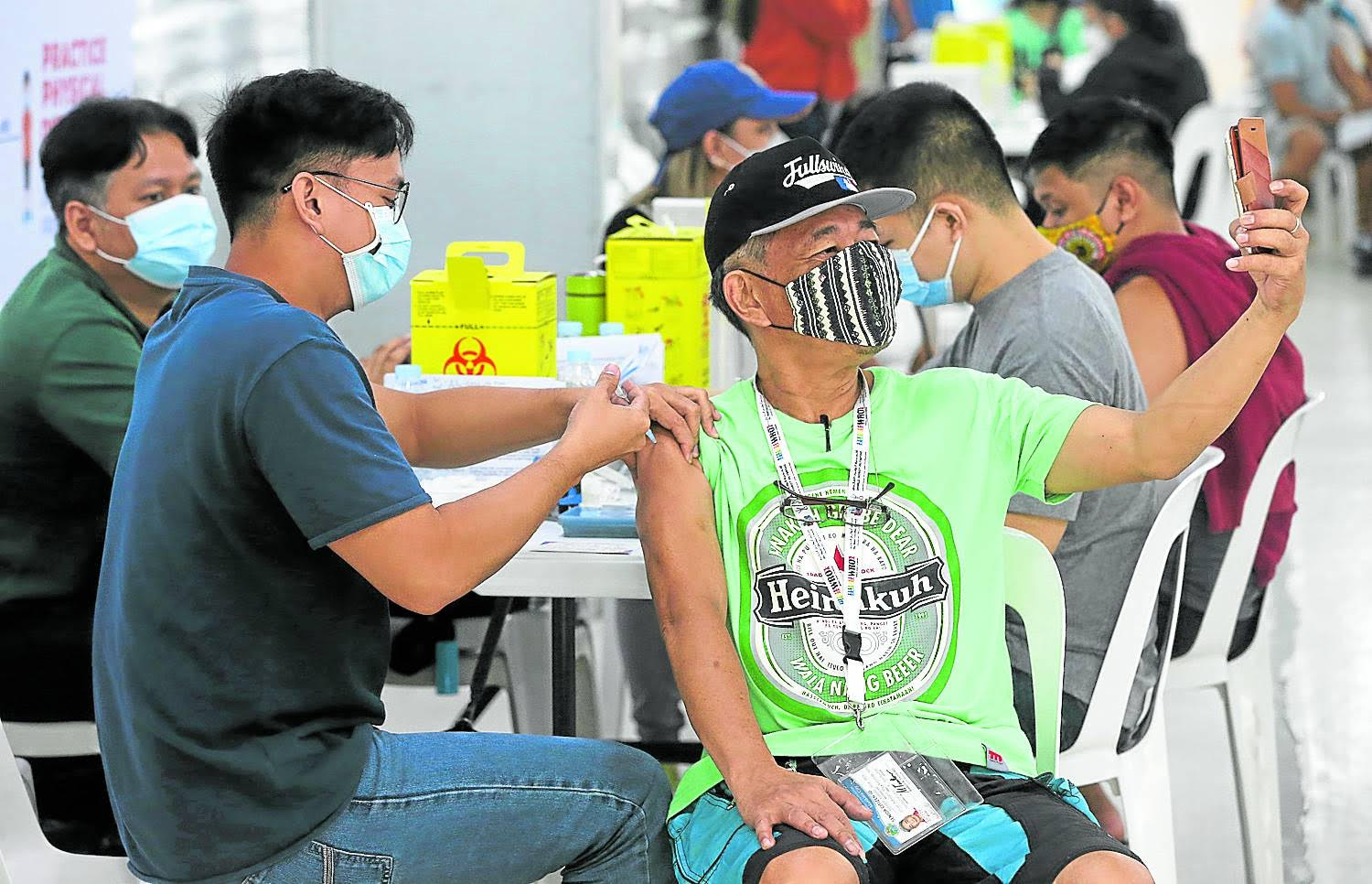
A Marikina resident takes a selfie while getting a booster shot. NIÑO JESUS ORBETA/FILE PHOTO
The COVID-19 restrictions in the country may be further relaxed only when half of the eligible individuals, or about 24 million, get inoculated with first booster shots to guarantee a sufficient protection for most of the population, a top health official said on Friday.
This was among the conditions that would have to be met before the government could go ahead with more relaxed COVID-19 policies and fewer mobility restrictions as seen in other countries.
“The restrictions would have to be discussed with experts and other agencies. But in terms of the threshold, we have to increase the wall of immunity of the population. For us, we need to [get] at least 50 percent of the eligible population … to get their first boosters,” Maria Rosario Vergeire, officer in charge of the Department of Health (DOH), said at a press conference.
She said this was equivalent to around 23.9 million individuals out of around 47 million people that were due to get their first booster shots. According to the Aug. 11 data from the DOH, only 16.7 million had availed of the first boosters, while 1.7 million people received their second booster shots.
Uphill campaign
“If we could raise the [number] of first booster shots, then maybe some of the restrictions may be reviewed … But if not, then the lifting of restrictions will not be discussed,” Vergeire said.
The “PinasLakas” campaign of the government has been struggling to ramp up inoculation since it began on July 26. As of August 9, only 17,514 seniors had been fully vaccinated, while 1.3 million individuals got boosted.
Vergeire said that the DOH has shifted its priorities in its COVID-19 management to protecting the health-care system and the most vulnerable from severe and critical infection.
READ: DOH bares guidelines for 2nd COVID boosters for adults
Reacting to the recent development in the United States wherein COVID-19 quarantine protocols have been further eased, Vergeire said that the Philippines was “aligned” with the United States government’s strategy of passing the responsibility to the citizens.
“The direction of the US government is to put the focus and responsibility on their citizens. And also here in the Philippines, that is our direction. We will encourage people to take care of themselves,” she noted.
“Aside from government interventions, people should know how to protect themselves,” she said, adding that people should learn to live with the virus.
In an August 11 advisory, US Centers for Disease Control and Prevention said that it has “streamlined” its COVID-19 guidelines due to better access to vaccines and treatments. Among the adjustments were the lifting of mandatory quarantine to people exposed to COVID-19 regardless of vaccination status.
Emerging trend
The pace of COVID-19 transmission in Metro Manila has shown “signs of a downward trend” in recent days, while cases in areas in the rest of Luzon as well as the Visayas are also plateauing, according to the DOH.
But these trends have to be monitored in the next two weeks to say that infections are really slowing down, Vergeire said.
“Cases are plateauing, but this does not give us the conclusion that it is declining. We’re still monitoring the trends because [of] different factors like [number] of samples submitted for testing,” she said.
While the positivity rate of Metro Manila fell to 17.7 percent in the recent week, about 40 to 50 percent of new and active infections come from the capital region.
Metro Manila and the Cordillera Administrative Region were also the only two regions that remained at moderate risk for having an average daily attack rate (Adar) of 9.17 and 7.96 cases per 100,000 population.
READ: COVID-19 active cases in PH top 40,000 as 4,661 more contract disease – DOH
The Adar of the rest of the regions was still at low risk, but Cagayan Valley and Calabarzon were nearing the 6-percent threshold for moderate risk classification.
COVID-19 cases at the national level remained at low risk as well, with an Adar of 3.51 infections per 100,000. A total of 22,178 infections were recorded from Aug. 5 to Aug. 11 nationwide.
Meanwhile, a “steady uptrend” in intensive care unit admissions as well as severe and critical hospitalizations has been observed since July, but these indicators remained at low risk, Vergeire noted.
As of August 10, only 9.27 percent of total admissions were severe and critical cases, which remained below the 1,000 level. Admissions were still mainly asymptomatic and mild infections at 14.98 percent and 14.77 percent, respectively.